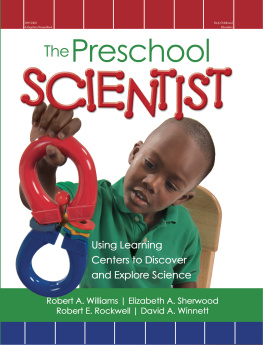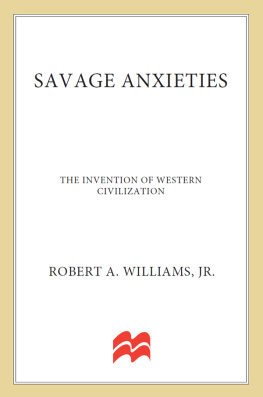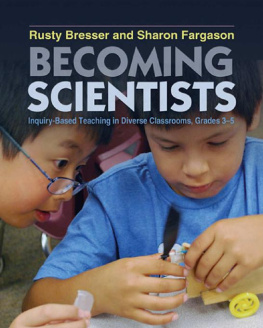Contents
The
Preschool Scientist
by
Robert A. Williams, Elizabeth A. Sherwood,
Robert E. Rockwell, and David A. Winnett
Dedication
To all my new teacher and children friends in Texas.
You have made me feel welcome. Thanks
and lets teach those kids science!
R. A. W.
To Will and Jene, Jennifer and Lee, and
grandchildren, Phillip and Anna,
our youngest scientists.
E. A. S.
To Donna, who has been a friend, wife, mother, grandmother,
and great-grandmother extraordinaire. To Susan and Janet,
my daughters, who are living the joys of grandparenthood.
To my grandchildren, Teri, Robert, Amanda, Kathryn,
and Michael, and my great-grandchildren
Tyler, Megan, Ethan, Delilah, Mya, and
Stella, who give me endless joy.
I love you all.
R. E. R.
To my beautiful wife Sharon, who
has put up with my dreams and
schemes for over 40 years.
D. A. W.
2010 Robert A. Williams, Elizabeth A. Sherwood, Robert E. Rockwell, and David A. Winnett
Published by Gryphon House, Inc.
PO Box 10, Lewisville, NC 27023
800.638.0928 (toll-free); 877.638.7576 (fax)
Visit us on the web at www.gryphonhouse.com
All rights reserved. No part of this publication may be reproduced, stored in a retrieval system, or transmitted in any form or by any means, electronic, mechanical, photocopying, recording or otherwise, without the prior written permission of the publisher. Printed in
the United States of America. Every effort has been made to locate copyright and
permission information.
Reprinted October 2011
Library of Congress Cataloging-in-Publication Data
Williams, Robert A.
The preschool scientist / by Robert A. William s... [et al.].
p. cm.
Includes index.
ISBN 978-0-87659-130-7
1. ScienceStudy and teaching (Preschool) I. Title.
LB1140.5.S35W57 2010
372.35049dc22
2010008480
Bulk purchase
Gryphon House books are available for special premiums and sales promotions as well as
for fund-raising use. Special editions or book excerpts also can be created to specification.
For details, contact the Director of Marketing at Gryphon House.
Disclaimer
Gryphon House, Inc. and the authors cannot be held responsible for damage, mishap,
or injury incurred during the use of or because of activities in this book. Appropriate and reasonable caution and adult supervision of children involved in activities and
corresponding to the age and capability of each child involved is recommended at all
times. Do not leave children unattended at any time. Observe safety and caution at all times.
Introduction
Using Science to Discover and Explore the World
Young children are eager and ready to learn. To sustain their eagerness and interest, it is important
to introduce children to scientific exploration through engaging and meaningful experiences. With careful and intentional planning, we can help our preschool scientists learn the concepts and skills that will deepen their understanding of the world around them.
Consider for a moment an educational scenario. Suppose two adults, Fred and Maria, enroll in a
craft class. In the first session, their teacher introduces them to working with stained glass, and they practice cutting glass and learn to connect the pieces. Fred and Maria come to the second session ready to learn more. Instead, the teacher introduces ceramics. Fred and Maria learn a little about ceramics and are excited about creating something new. Fred and Maria come to the third session ready to continue with ceramics. The clay is gone; the teacher has replaced it with equipment for wood carving. Instead of learning skills, Fred and Maria are learning frustration.
Too often, this is what we do to children. Instead of giving them the self-confidence that comes
with mastering new ideas or skills, we move them quickly from one topic to the next. We are subtly teaching them to be satisfied with learning a little about many things. By limiting the number of topics presented in The Preschool Scientist , we are giving children more opportunities to experience feelings of competence and mastery.
Our philosophy is that it is better to help children acquire a real understanding of a few concepts
than to give them fragments of many topics. Materials should be accessible, and the curriculum should be developed in such a way that children can return to or repeat experiences that they may have completed some time ago. Repetition reinforces childrens awareness of their own competence, which ultimately results in confidence.
The Preschool Scientist exposes children to much more than science skills and concepts. It gives them the opportunity to explore, experiment, create, and problem solve. The approach in The Preschool Scientist also encourages children to refine their use of language as they talk about what they do
or explain what they discover. And children can apply their emerging mathematical skills in the meaningful context of discovery. The Preschool Scientist provides teachers with a curricular framework that engages the spirit of excitement for discovery that dwells in the minds of all children, wherever they live and learn.
Chapter 1:
Science in the Preschool Classroom
We know that children learn more by doing than by listening. We also know that children come to school with widely varying backgrounds, experiences, and knowledge. The Preschool Scientist helps teachers by providing purposeful activities that are exciting and intellectually challenging for young children in all kinds of settings.
Goals for Early Childhood Science
The goals that follow establish a foundation for early childhood science learning:
Provide an environment that supports active discovery.
Promote the development of fundamental problem-solving skills.
Promote the dispositions of good scientific problem solvers.
Promote childrens awareness of careers in science, mathematics, and technology.
Raise childrens comfort and confidence levels with science through conscious efforts to counter bias against science.
Promote development of a knowledge base of basic scientific principles and laws, providing the foundation upon which a clear and accurate understanding of the
world can develop. A solid foundation reduces the risk of children acquiring misconceptions that may hinder their understanding of more complex science concepts later on.
Narrowing the Range of Science Themes to Promote Successful Learning
Often activity guides for young children contain a scattered collection of science concepts and terms that children are expected to absorb. A hurried exposure to science may fail to provide the opportunity for the rich conceptual development that is possible with a more coherent, thoughtful approach. Just think of the story of Fred and Maria (from the introduction) struggling in their craft class. The Preschool Scientist works with only three basic science process skills. This enables children ages three and four to be totally immersed in the science processes that are within their developmental capabilities. By focusing on a small number of core concepts, children will have enough time to spend with the materials and concepts to master them.
The Preschool Scientist provides many approaches for developing childrens understanding of three basic and crucial science process skills:
Focused Observing,
Observing to Classify, and
Organizing and Communicating Observations.
Through explorations in centersArt, Blocks and Building, Discovery, Dramatic Play, Literacy, Messy Materials, and Outdoorschildren have many opportunities to observe, classify, and communicate. The development of these skills is supported by the questions you ask children and your observations of the children as they work.









